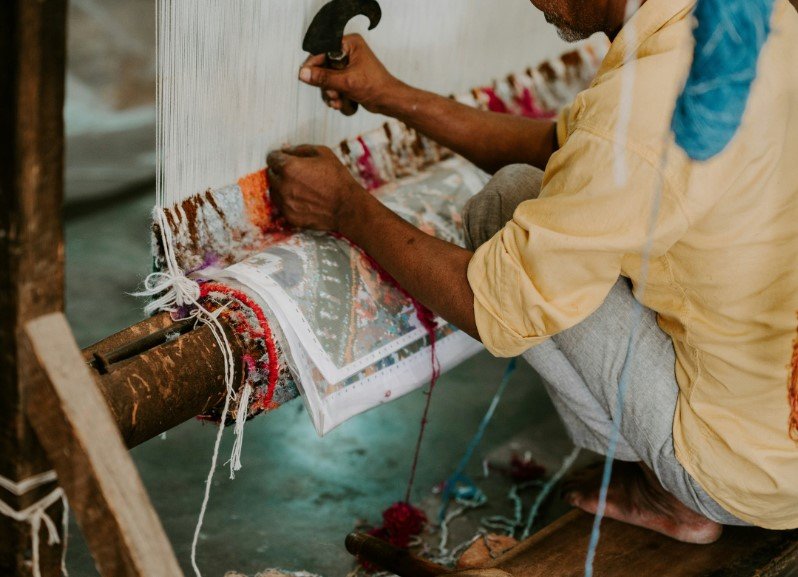Saqiya Abu Sha’ra turns looms into livelihoods, keeping a post-war tradition alive through silk, soul, and survival
In Saqiya Abu Sha’ra, a small village tucked away in Egypt’s Monufia province, carpets don’t just decorate homes—they build them. Each thread of silk is a piece of family history, woven not just for beauty, but for survival, pride, and inheritance.
At a time when automation and global imports threaten handmade crafts, this village is doing something remarkable: keeping its 70-year-old weaving culture alive, one loom at a time.
From Cairo to the Countryside: How a Craft Found Its Way Home
It all began with a return journey.
Back in 1950, a young man from the village went to Cairo and picked up a skill most Egyptians hadn’t even heard of: carpet weaving. But instead of settling in the capital, he came home with it. Literally. He opened a small workshop and invited the community in.
Ahmed Abdel Qader Fathallah, now a veteran weaver, remembers that time well.
“He brought something completely new here,” Fathallah said, sitting near a half-finished silk rug. “People were curious. They started learning, first a few, then many. It spread fast.”
Soon, looms began popping up in family homes. Fathers taught sons, mothers taught daughters. No special school. No state initiative. Just thread, time, and trust.

Weaving With Purpose—and Silk
The carpets aren’t cheap. And that’s part of the point.
One square meter of pure silk can sell for up to 20,000 Egyptian pounds—roughly $400 USD. It’s a big number in a village where monthly incomes can be a fraction of that.
Some weavers work with semi-silk blends, or even cotton, fetching more modest prices around 5,000 pounds per meter. But when you touch a full silk carpet, the difference is clear. Softer. Smoother. It glows.
Fathallah believes their craftsmanship matches the legendary quality of Iranian carpets.
“We know what they cost, what they look like,” he said, “and we know ours are just as good—sometimes better.”
More Than Work: It’s a Way to Keep Children Close
The work is demanding. Sitting at a loom for hours, tying knots by hand, keeping track of complicated patterns—it takes patience. Lots of it.
But for parents like Adel Hasan Wahdan, who’s both a school manager and an artisan, that effort is worth it.
“My kids are going to grow up and want their own life,” Wahdan explained. “But this gives them something close to home. They can earn money, build skills, and still be here with me.”
He doesn’t just mean financially.
Wahdan worries about young people commuting to factories or drifting to Cairo. The long hours, the risks, the strangers, the uncertainty. So he’d rather have them weaving next to him.
“Especially my daughters,” he added. “If they’re working at home, I feel better. I know who they’re around. I know they’re safe.”
Selling Tradition in the Digital Age
Lately, the internet has become their storefront.
Villagers now post photos on Facebook, WhatsApp, and even TikTok. Sometimes a video of a loom in motion goes viral, attracting buyers from Cairo, Alexandria—even Europe.
It’s not fancy marketing. But it works.
-
Handmade silk carpets are sold via local networks and online groups.
-
Clients often order custom sizes, colors, or Arabic calligraphy patterns.
-
Some buyers visit the village directly to see the carpets being made.
The goal is to expand without losing the intimacy that makes the craft special.
“We can’t compete with machine-made rugs on price,” said Fathallah. “But we don’t have to. Our customers want what’s real.”
Keeping the Looms Alive—One Generation at a Time
There’s no formal business plan. No big funding. But there’s something arguably more powerful: pride.
That’s what keeps the looms from falling silent.
Many families in Saqiya Abu Sha’ra treat weaving like farming—an inherited responsibility. Children often learn by watching their parents work. By the time they’re teens, their hands already know what to do.
The rhythm of weaving becomes muscle memory.
Still, it’s not all rosy. Some worry about the next generation.
Smartphones, online gigs, and city jobs tug at younger minds. Not everyone wants to spend hours knotting threads. Some families have even sold their looms.
But others, like Wahdan’s, are holding the line. He believes it’s a craft that will always find believers.
“Even if my kids leave it for a while,” he said, “they can always come back. The loom will still be here.”
A Craft Worth Protecting
Egypt’s government has declared carpet weaving part of its intangible heritage list. It’s a nice title, but the weavers aren’t looking for fanfare. They want something more practical—support.
Training centers, tools, maybe subsidized silk. Anything to help pass the torch.
But in the absence of state support, Saqiya Abu Sha’ra is finding its own way. Quietly. Steadily.
With every square meter they sell, with every knot tied by hand, they’re keeping a legacy alive—not just of beauty, but of belonging.
